Opened December 27, 1968 Line length 26.5 km (16.5 mi) Stations 27 | Daily ridership 600,570 (2014) Depot(s) Shimura Track gauge 1,067 mm (3 ft 6 in) | |
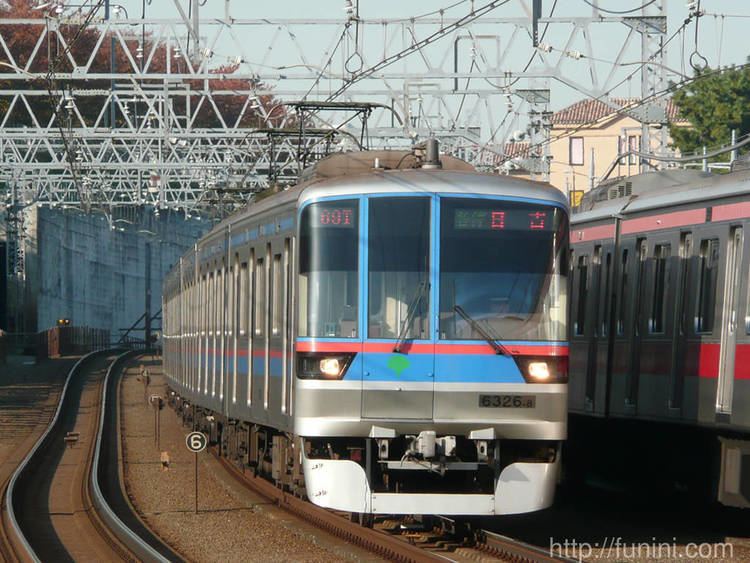 | ||
Terminis Meguro Station, Nishi-Takashimadaira Station | ||
Toei mita line
The Toei Mita Line (都営地下鉄三田線, Toei Chikatetsu Mita-sen) is a subway line of the Tokyo Metropolitan Bureau of Transportation (Toei) network in Tokyo, Japan. The line runs between Nishi-Takashimadaira in Itabashi and Meguro in Shinagawa. Trains continue with direct service into the Meguro Line of Tokyu Corporation for Hiyoshi. The portion between Shirokane-Takanawa and Meguro is shared with the Tokyo Metro Namboku Line.
Contents
- Toei mita line
- Toei mita line train departs kasuga station
- Overview
- Station list
- Rolling stock
- Present
- Past
- Maintenance facilities
- History
- References
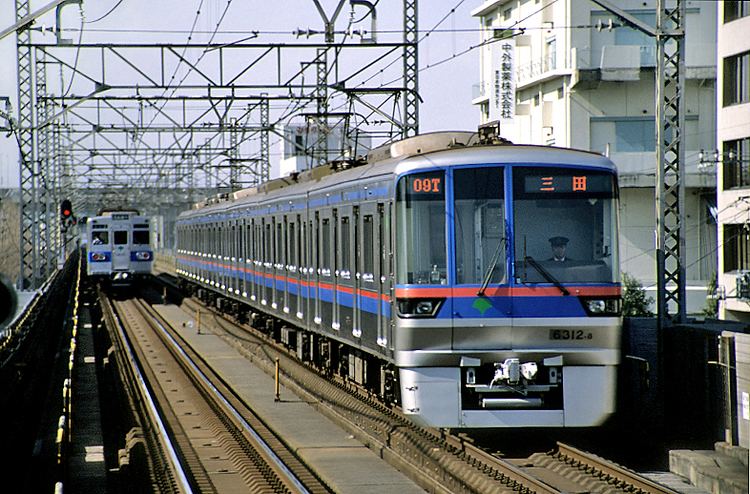
On maps and signboards, the line is shown in "blue" (O). Stations carry the letter "I" followed by a two-digit number.
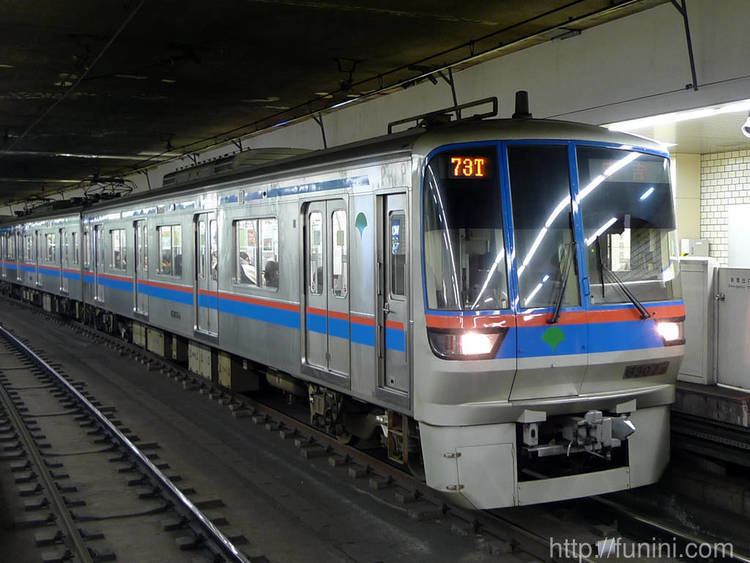
Toei mita line train departs kasuga station
Overview
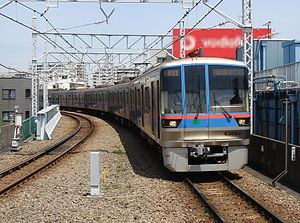
Platforms on the Mita Line are equipped with chest-height automatic platform gates that open in sync with the train doors. The line was the first in the Tokyo subway system to have low barriers. The Tokyo Metro Namboku Line has used full-height platform screen doors since its opening.
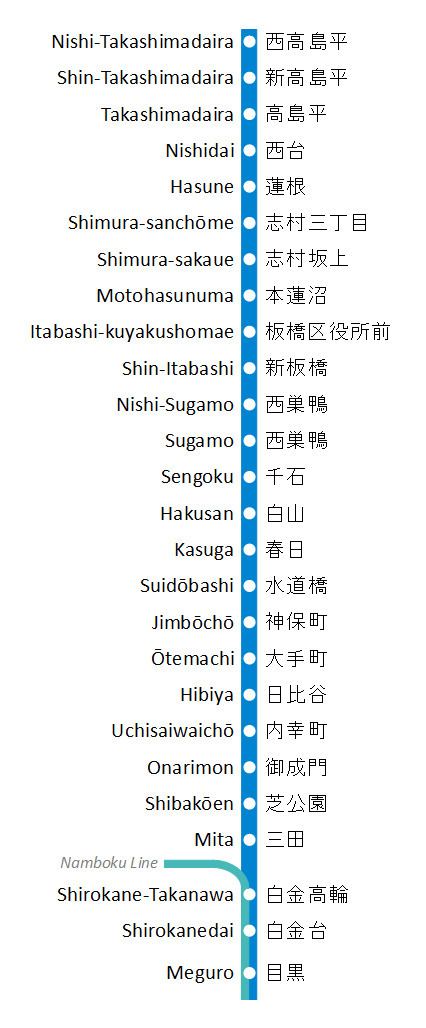
The right-of-way and stations between Shirokane-Takanawa and Meguro are shared with the Tokyo Metro Namboku Line - a unique situation on the Tokyo subway where both operators share common infrastructure. Under an agreement of both parties, the fare for this section is calculated on the Toei system for passengers traveling to stations on the Mita Line past Shirokane-Takanawa, using the Tokyo Metro system for those travelling on the Namboku Line past Shirokane-Takanawa, and on the system "most beneficial to the passenger" (presently the Tokyo Metro schedule) for travel solely on the shared section.
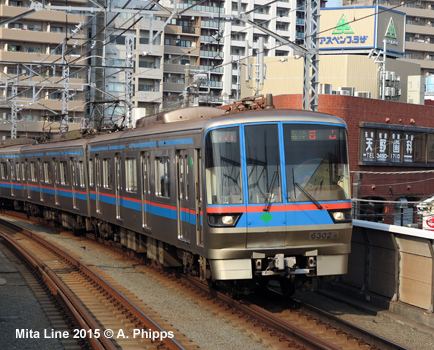
According to the Tokyo Metropolitan Bureau of Transportation, as of June 2009 the Mita Line is the ninth most crowded subway line in Tokyo, running at 164% capacity between Nishi-Sugamo and Sugamo stations.
Station list
All stations are located in Tokyo.
Rolling stock
All trains are 6-car sets unless otherwise noted.
Present
Past
Maintenance facilities
History
The Mita Line was first envisioned in 1957 as a northern branch of Line 5 (the present Tōzai Line), serving the section between Ōtemachi and Itabashi. Under a revised proposal in 1962, the line was made independent and its construction undertaken by the Tokyo Metropolitan Government. The new line (Line 6) was planned to run from Gotanda Station on the southwestern side of the Yamanote Line through central Tokyo, with its northern extensions via Yamatochō (大和町) in Itabashi (near present Itabashi-honchō), diverting to Kami-Itabashi and Shimura (志村) (present Takashimadaira). The southernmost portion, from Sengakuji to Nishi-Magome and Nishi-Magome depot, was to be shared with Line 1 (Asakusa Line); therefore, Line 6 would be 1,435 mm (4 ft 8 1⁄2 in) gauge.
Due to political considerations, the design of the Mita Line changed several times during the early 1960s. There were plans for it to run to Toda, Saitama, to serve a boat-racing venue for the 1964 Summer Olympics. The government of Saitama also proposed the construction of a new subway line which would allow through service on the Mita Line as far as Ōmiya Station. In 1964, these plans were changed to allow the Mita Line to connect with the Tōbu Tōjō Line via a branch to be built by Tobu between Yamatomachi (大和町) (now Wakōshi), and Shimura, the northern end of Line 6. At the southern end the junction with the Tokyu network would be via a connecting line, which would be constructed by Tokyu from Sengakuji to Kirigaya (桐ヶ谷) on the Tōkyū Ikegami Line; the route would continue to the then-Den-en-toshi Line and finally west, down to Nagatsuta. As a result, the construction standards of Line 6 were based on those of Tobu and Tokyu (such as 1,067 mm (3 ft 6 in) gauge track and 20-meter-long cars). A depot was planned at Shimura, independent of the Nishi-Magome depot on Line 1.
However, both Tokyu and Tobu decided the following year to operate their through services with the Teito Rapid Transit Authority (TRTA, now Tokyo Metro) lines instead. With no through service opportunities available the Tokyo Metropolitan Government began construction on the central portion of the line, leaving the plans for the Itabashi and Mita ends open for future development. This required an extension somewhere south of Seishōkō-mae (清正公前) (present Shirokane-Takanawa), probably to the then-Mekama Line of Tokyu (on the commencement of inter running to Mita and Namboku lines, the Mekama Line was divided into the Meguro Line and Tōkyū Tamagawa Line) which competed with TRTA Line 7, later called the Tokyo Metro Namboku Line.
The first segment of the line opened on December 27, 1968, between Sugamo and Takashimadaira (10.4 km). The line was extended a further 7.3 km south to Hibiya on June 30, 1972 and 3.3 km further south to Mita on November 27, 1973. The northern 1.5 km extension (originally licensed to Tobu and later transferred to the Tokyo government bureau of transportation) was completed on May 6, 1976. For the next 24 years, the line operated between Mita and Nishi-Takashimadaira; the authorized Mita and Sengakuji section had been left uncompleted.
In 1985 the then-Ministry of Transport finally settled the plan regarding the southern extension of the line, and shelved all plans for further extension to the north due to the development of the Saikyō Line. On September 26, 2000, the final 4 km segment from Mita to Meguro opened, and through service to the Meguro Line of Tokyu began at the same time, at which point the line switched to driver-only operation.
